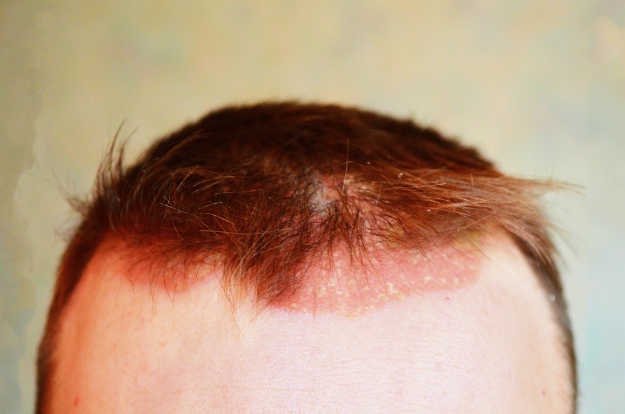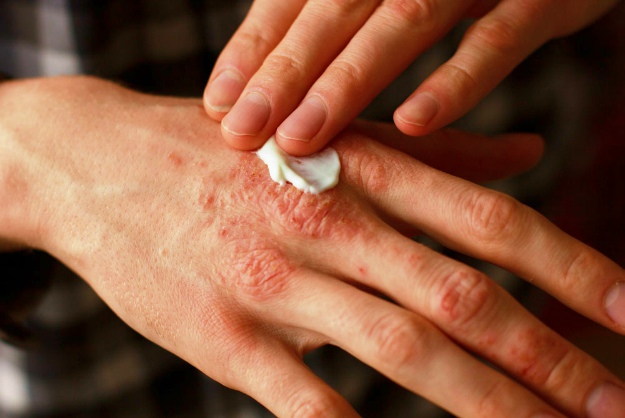

What is psoriasis, exactly? And isn’t it kind of a minor problem? If you’ve ever heard your psoriasis described as a non-serious condition, you know how frustrating this mindset can be. In truth, many people with this chronic skin condition suffer greatly during flare-ups. But whether you’re coping with aching joints and burning skin, or just trying to get rid of a stubborn flaky patch, the need for an effective psoriasis treatment is probably always your mind.
In this article:
Psoriasis Explained and How to Treat It
What Causes Psoriasis?
What causes psoriasis can vary from person to person. Psoriasis is an immune system condition. Researchers believe it’s connected to overactive T-cells in the bloodstream. If T-cells malfunction, they begin attacking healthy skin cells. They also signal the body to create an abnormally fast turnover of skin cells. The result is a scaly rash from cell-overproduction, along with related inflammation.
So what sets off T-cells? It depends on the patient. But once psoriasis gains a foothold, you’re vulnerable to a range of triggers. Common flare-up causes include bacterial infections, injuries, vitamin deficiency, and anxiety. Bad habits like drinking and smoking can also be factors in recurring rashes and related psoriasis symptoms.
Common Symptoms

How can you tell whether your psoriasis is mild, moderate, or severe? The National Psoriasis Foundation (NPF) gives a psoriasis definition for “mild” as rashes which cover less than 3% of the body. “Moderate” psoriasis means 2-10% of the body is affected.“Severe” designations are reserved for patients with more than 10% of the body covered with rashes.
Along with the severity level, specific psoriasis symptoms can vary greatly. Among the most common symptoms are:
- Itchy patches of skin that may also have a burning sensation.
- Large swathes of skin that are red, and covered with gray/silver scales. The scales themselves tend to flake off before new ones form.
- Skin that is dry and cracked, to the point of occasionally bleeding.
- Small patches of flaking skin. These aren’t always red or scaly, but they’re chronic. They can appear anywhere, including on the scalp.
Psoriasis Sub-types
It’s not uncommon to have more than one type of psoriasis, which is why many people have overlapping symptoms. But, it can help to pin down your exact sub-type.
Plaque Psoriasis
The most common form of psoriasis is known as plaque psoriasis. This is characterized by classic patches, plaque, or red skin covered with silvery scales. These patches might appear anywhere on the body, including inside the mouth. Some people have several inflamed areas during a flare-up, while others have only one or two.
Guttate Psoriasis
Kids and teens prone to sore throats and other bacterial infections are the groups most likely to develop guttate psoriasis. The lesions of guttate psoriasis are tear-dropped shaped. These red lesions have scales, but they aren’t as rough or large plaque psoriasis scales.
Nail Psoriasis
People with nail psoriasis have fingernails or toenails that become thicker, discolored, or ridged. The nails might also begin to pull away from the skin, or even disintegrate.
Pustular Psoriasis
Pustular psoriasis, as the name suggests, makes itself known with pus-filled, itchy blisters. It’s one of the more rare forms of psoriasis, so at first glance, you may think you have poison ivy. But unlike poison ivy or oak, pustular psoriasis keeps reappearing. Some people experience the rash and blisters on large areas of their skin. Others only get them between their fingers or the undersides of their feet.
Inverse Psoriasis
Inverse psoriasis tends to invade the folds of skin, including armpits, groin and the undersides of the breasts. These patches of red skin don’t have silvery scales, but they are often uncomfortable. When skin folds rub together or sweat, the condition worsens.
Psoriatic Arthritis
Psoriatic arthritis is a particularly difficult condition to cope with. Not only do patients have the classic psoriasis skin rash, but the condition also causes joints to ache and swell.
Erythrodermic Psoriasis
Erythrodermic psoriasis is definitely severe, going by the NPF’s parameter of more than 10% of the body affected. This type of psoriasis can literally cover the entire body, causing intense discomfort and itching. Fortunately, this is the rarest form of psoriasis.
How to Treat Psoriasis

Knowing what psoriasis is, especially the type you have, will greatly help with the management and treatment of flare-ups. There are currently no known cures for psoriasis. That’s why the emphasis is on treating symptoms and lowering the incidences of future flare-ups. Your general practitioner or dermatologist is likely to make recommendations based on your skin condition’s severity and location. Here are a few treatments that have proven helpful:
Phototherapy
Too much sun can obviously put you at risk for skin cancer, but brief, daily exposure to the sun can help. Phototherapy slows the unnaturally rapid amount of skin cell production that leads to scales and inflammation. Your doctor can direct you on how much time you should spend in the sun, as well as what kinds of precautions you should take.
There are also phototherapy treatments you can receive from specialists. UVB therapy involves placing the psoriasis patient near an artificial light source, or the patient might be treated with a special laser. Other variations of phototherapy start with a topical application of coal tar or taking special oral medications. Each of these treatments makes skin more responsive to healing UV rays.
Prescription Psoriasis Medications
Psoriasis patients may need to take prescription medicine to control moderate to severe symptoms. Some are formulated to slow cell production. Others alter the entire immune system to control the T-cells responsible for the chronic skin condition.
Topical or oral retinoids are another option. Retinoids are synthetic forms of vitamin A. They’re useful as inflammation fighters and to limit skin cell production.
As with most prescription medication options, risks of side-effects should be considered. Potential side effects include upset stomach, swollen lips, hair loss, and liver damage. For the medications that alter your immune system, your ability to resist serious illnesses may be seriously compromised.
Tracking Triggers
Different irritants affect psoriasis patients in different ways. The next time you experience psoriasis rashes and other symptoms, try to remember what was happening in your life just before a flare-up. Were you stressed out before the rashes or burning sensation started? Had you been partying the weekend before? Has your diet been less than healthy lately?
After a few bouts of psoriasis, you may soon spot a pattern. You may break out just before exams or other stressful events. If so, start finding ways to ease tension as a preemptive strike against psoriasis. Similarly, after a week of too much junk food, consider taking supplements. Vitamin D deficiency has been linked to psoriasis. Of course, it’s never a good idea to drink to excess or to smoke. The fact that these can trigger psoriasis symptoms is just another reason to kick these bad habits.
Home Treatments
If you’re having a mild to moderate flare-up, home treatments using household ingredients can ease some symptoms. Lukewarm baths with Epsom salts or colloidal oatmeal soothes itches and aching joints. These types of baths are also good for removing dead skin cells. Be sure not to rub too vigorously, or you’ll risk further skin irritation.
Topical Healing
A moisturizing cream is a crucial treatment for psoriasis. This chronic skin condition is excessively drying to the skin. In addition, the right cream creates a hydrating barrier between your fragile skin and environmental triggers. Finally, psoriasis-appropriate moisturizing skin products have ingredients that soothe itching and burning, while also easing inflammation.
Look for aloe vera when choosing a cream for psoriasis. According to the Mayo Clinic, this superior ingredient addresses psoriasis in several ways. Gel from the aloe vera plant’s leaves has anti-inflammatory properties, which decreases redness and swelling. Aloe vera can also soothe itching and irritation, while gently loosening scales.
Shea butter is another ingredient to look for in your moisturizer cream. It’s a vitamin-rich, natural ingredient known for repairing rough, raised skin. Like aloe vera, it’s also soothing and anti-inflammatory. Amaranth oil is also a nutrient-dense anti-inflammatory. It also boasts the ability to help skin protect itself from environmental irritants.
Other healing, hydrating botanicals to look for in an anti-psoriasis cream include essential oils like honey, jojoba oil, avocado oil, and safflower oil. Soothing, cooling essential oils such as lavender and peppermint are also linked to psoriasis relief.
Although there are treatments for psoriasis available on the market right now, taking care of your health naturally is greatly recommended as well. Start with your gut. Find out what food to avoid in this video from Foods4Health:
Don’t suffer alone if you suspect your skin condition is a chronic one. Your general practitioner or a dermatologist can help you diagnose your type of psoriasis and discuss the pros and cons of psoriasis medications. Your doctor can also suggest home treatments, including healing creams, that can also soothe symptoms.
What is psoriasis? How do you treat it naturally? What else do you need to know about psoriasis management? Post your questions below!
Up Next: Psoriasis Creams News | Scaling Back The Scales

1 Comment
What Is Psoriasis? Psoriasis Symptoms and Treatment – Life Style – August 24, 2019:
[…] Click Here […]
Comments are closed.